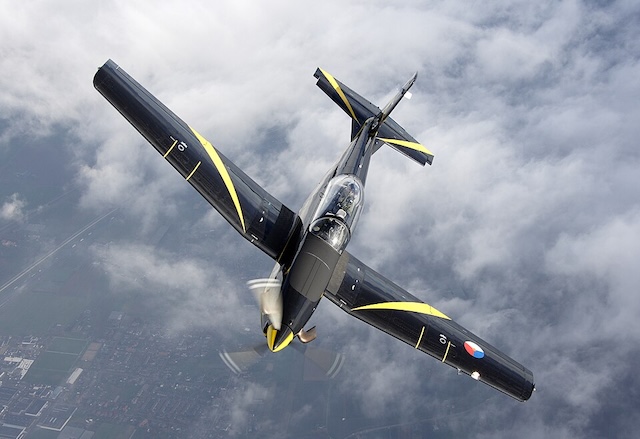PC-7 Turbo Trainer
Summary
| Category | Military Training Aircraft |
| Origin country | 🇨🇭 Switzerland |
| Manufacturer | Pilatus |
| First flight | 12 April 1966 |
| Year introduced | 1978 |
| Number produced | 618 units |
| Average unit price | $1.5 million |
Description
The Pilatus PC-7 Turbo Trainer was developed during the 1960s by the Swiss manufacturer Pilatus Aircraft, based on its preceding piston-powered P-3 model. A prototype, created by fitting a P-3 airframe first flew in April 1966. The program was subsequently suspended following an accident and a perceived lack of market interest. Work resumed in 1973, prompted by the oil crisis and the increasing age of existing trainer fleets. A modified P-3 flew again in 1975, leading to a major redesign that included a new one-piece wing with integral fuel tanks. The first production aircraft performed its maiden flight on August 18, 1978, receiving civil certification that December, with initial deliveries to Burma and Bolivia commencing shortly thereafter. By the 1990s, Pilatus developed the PC-7 Mk.II M for the South African Air Force, integrating the advanced airframe and avionics of the PC-9 with the PC-7's more economical engine.
The PC-7 is a low-wing, tandem-seat trainer distinguished by its adoption of a turboprop engine, a bubble canopy for enhanced visibility, and a single-piece wing design. The airframe allows for a full range of training maneuvers, including aerobatics, instrument, and tactical flight. Over its service life, the PC-7 has been subject to various modernizations. Several third-party companies offered avionics upgrades, including new mission computers and head-up displays. The Swiss Air Force upgraded its fleet with glass cockpits (NCPC-7) and later with enhanced communication and a traffic collision avoidance system (PC-7 WE). The latest PC-7 MKX version, announced in 2021, features modernized avionics and an integrated ground-based training system that incorporates virtual and mixed reality simulation technology.
Designed with combat potential, the PC-7 is equipped with six underwing hardpoints capable of carrying a total of 1,040 kg (2,294 lb) of external stores. Though sold primarily as a trainer, these hardpoints allow for the mounting of various munitions, including bombs and rocket pods. Several operators have armed the aircraft for combat roles, such as the Guatemalan Air Force, which deployed them with gun pods and rocket pods for close air support missions. Export controls by the Swiss government have often stipulated that aircraft be delivered without armament capabilities, a policy which has been a point of political controversy.
The PC-7 has been operated by over twenty air forces worldwide and by civilian users for applications such as aerobatic displays. Its deployment in conflict zones, often in violation of export agreements, has been a notable part of its history. The Guatemalan Air Force used it for close air support during its civil war, while the Mexican Air Force deployed armed PC-7s during the Chiapas conflict in 1994, leading Switzerland to ban further sales to the country. In the 1980s, an Iraqi PC-7 reportedly shot down an Iranian AH-1J Sea Cobra helicopter during the Iran-Iraq War. The Chadian Air Force has also used its fleet for bombing missions, and the private military contractor Executive Outcomes operated armed PC-7s in Sierra Leone.
Main Variants
- PC-7: The original two-seat basic trainer aircraft powered by a Pratt & Whitney Canada PT6A-25A engine.
- PC-7 Mk.II M: A hybrid model developed for the South African Air Force, featuring the airframe and avionics of the PC-9 with the less powerful engine of the PC-7.
- NCPC-7: An upgraded version for the Swiss Air Force, notable for the integration of a modern glass cockpit.
- PC-7 WE: A further modernization of the Swiss NCPC-7 fleet featuring modified communication systems and a Traffic Collision Avoidance System (TCAS).
- PC-7 MKX: An updated variant with advanced avionics, new cockpit displays, and integration with a sophisticated ground-based training system.
Technical specifications
| Version: PC-7 | |
|---|---|
| Crew | 2 pilots |
| Operational range | 1,200 km (746 mi) |
| Endurance | 4 hours |
| Maximum speed | 412 km/h (256 mph) |
| Wing area | 16.6 m² (178.7 sqft) |
| Wingspan | 10.4 m (34.1 ft) |
| Height | 3.2 m (10.5 ft) |
| Length | 9.8 m (32.1 ft) |
| Service ceiling | 10,060 m (33,005 ft) |
| Empty weight | 1,330 kg (2,932 lbs) |
| Max. takeoff weight | 2,700 kg (5,952 lbs) |
| Climb rate | 10.9 m/s (35.8 ft/s) |
| Powerplant | 1 × turboprop Pratt & Whitney Canada PT6A-25A delivering 410 kW |
Current operating countries
| Country | Units | ||
|---|---|---|---|

|
India | 74 | |

|
Mexico | 63 | |

|
South Africa | 55 | |

|
Iran | 34 | |

|
United Arab Emirates | 31 | |

|
Switzerland | 27 | |

|
Angola | 22 | |

|
Malaysia | 20 | |

|
Myanmar | 16 | |

|
Netherlands | 13 | |

|
Austria | 12 | |

|
Chile | 7 | |

|
Botswana | 5 | |

|
Uruguay | 5 | |

|
Brunei | 4 | |

|
Bolivia | 2 | |

|
Chad | 2 | |

|
Guatemala | 1 | |
All operators

